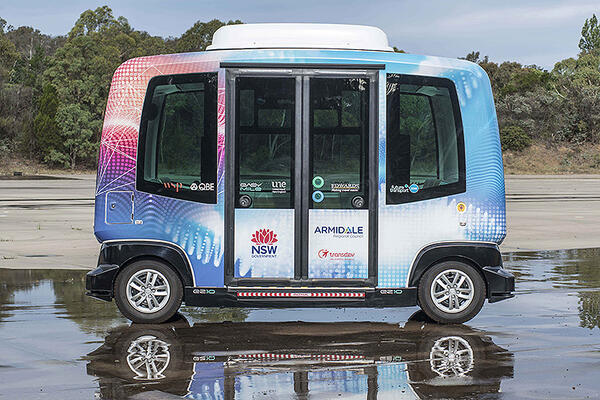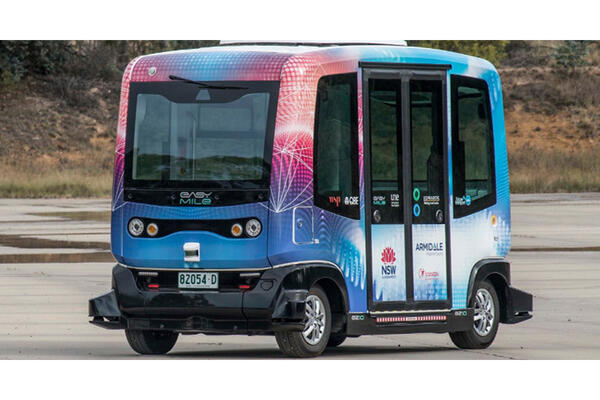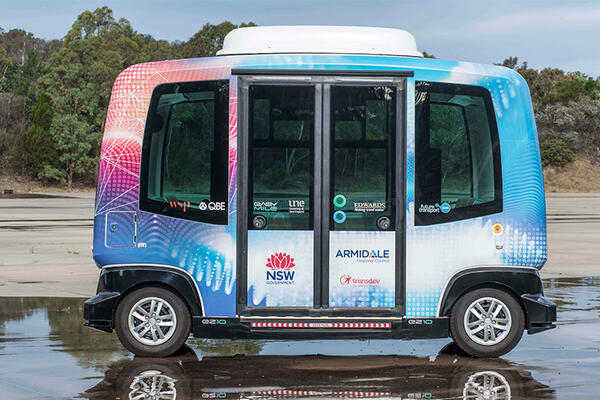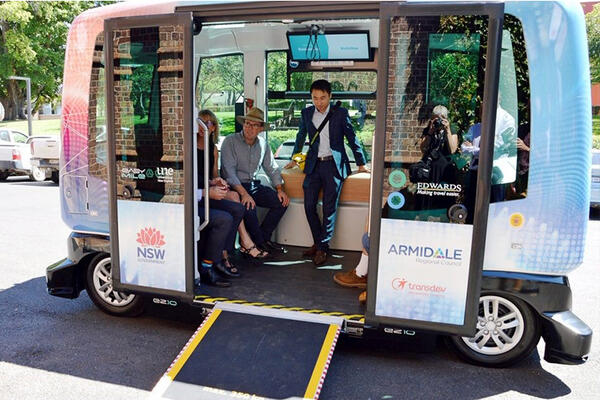
Armidale Regional Driverless Initiative (ARDI)
Armidale Regional Driverless Initiative (ARDi)
Transport for NSW has an interest in understanding how to prepare for connected and automated vehicles in metropolitan and regional areas where new transport modes can offer improved mobility solutions for local communities.
The Armidale Regional Driverless Initiative (ARDi) was established in 2019 to explore how automated vehicles can improve customer safety and mobility outcomes in regional NSW.
ARDi is a collaborative partnership between Transport for NSW, Armidale Regional Council, University of New England, EasyMile, WSP, Transdev, and Edwards Coaches.
The ARDi EZ10 automated shuttle is a battery-powered, 12-person electric vehicle. The shuttle operated during 2 trial phases in 12 months from 2019 to 2020.
Each trial phase targeted different customer groups in the local community and provided key learnings on the safe and efficient operation of automated vehicles as a public transport mode.
More information about each trial phase is listed below.
ARDi Phase 1 – University of New England (UNE) Campus
During February 2019 to June 2019 the ARDi shuttle began picking up passengers at the University of New England campus north-east of Armidale CBD.
Phase 1 had a strong focus on student transport needs, operating a route between the campus and college accommodation and generating strong technical, infrastructure and regulatory insights.
ARDi Phase 2 – Armidale CBD
Phase 2 was held in the Armidale CBD and allowed elderly passengers to catch the shuttle around key town areas such as the Mall, Town Hall, Old Courthouse and New England Hotel.
This part of the trial operated during October 2019 to February 2020 and focused on testing the technology supporting the ARDi shuttle including:
- Testing ARDi’s interactions with other vehicles and road infrastructure
- Evaluating and testing the operational control centres CAV operations
- Analysing the integration of real-time passenger data.
ARDi shuttle route maps:
Key learnings and outcomes
The 12 month trial successfully concluded in February 2020 and demonstrated that within limited operating domains, like low-speed university campuses and regional central business districts with less complex traffic environments, automated shuttles could provide transport services into the future once they become economically viable. Key learnings and outcomes included:
Low speed mapping process
Mapping, where ARDi reads and records the pre-determined operating environment, required ARDi to travel at 5 kph.
Despite a traffic management plan and traffic controls in place, the low limit used during mapping had a negative impact on some road users.
Future trials should consider the low speed required for mapping exercises and ensure these activities occur during low impact and low traffic environments.
Public perception of speed and driver behaviour
Initial responses from some road users (during mapping) to ARDi’s relatively low speed included poor driving behaviours such as tailgating and cutting back in sharply after overtaking.
Project partners ran community engagement and education sessions to combat these negative behaviours. These sessions were observed to have made a positive impact towards community attitudes and behaviour as more road users become more tolerant of the ARDi shuttle. Such community engagement sessions should form a key part of any future public led automated vehicle trial.
Environmental obstacles
During the trial the ARDi shuttle experienced a few environmental challenges including the presence of on-road autumn leaves. Leaves on the road created challenges for the shuttle and resulted in the vehicles emergency braking system being activated.
ARDi manufacturer EasyMile introduced a technology upgrade to alert the vehicle of environmental obstacles and reduce the occurrence of emergency braking. This upgrade has successfully been deployed across the EasyMile automated shuttle fleet.
Understanding Australian Design Rules (ADR)
Any vehicle being imported into Australia must follow ADRs – national standards for vehicle safety, anti-theft and emissions. The ADR process is not CAV specific and created some challenges for importing the vehicle.
ARDi required several exemptions and/or modifications to meet ADR requirements. Future CAV trials should consider the time and resources required to meet ADRs.
The learnings derived from the project will inform local and state government planning and policy. ARDi has given Transport for NSW and our supporting partners the insight required to start to build towards a transport revolution now by understanding how automated vehicles can operate safely and efficiently on our road network.
In 2020 ARDi was nominated for the Intelligent Transport Systems (ITS) Australia, Connected and Automated Vehicle Award.
More information about the ARDi shuttle trial can be found via the project summary report and the image and video gallery.
ARDi'S Australian firsts
- First automated shuttle trial to operate in a mixed traffic CDB environment
- Australia’s longest shuttle route providing service nine hours per day
- First automated shuttle to integrate public transport trip planner software and real time passenger information
ARDi video and image gallery
Image
Image controls:
Image
Image controls:
Image



Image controls:


